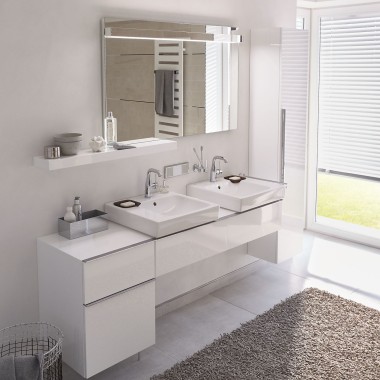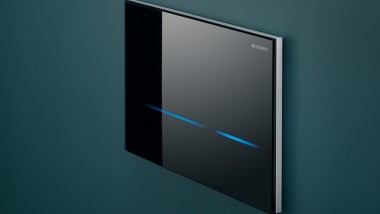White: a multi-faceted color
Have you ever wondered why white is so popular in the bathroom, and realised that this color doesn’t necessarily always look the same?
Anyone who has ever stood in front of a shelf of white paint in the hardware store knows that the color white has many nuances. There are around 100 listed shades of white. The options include old white, polar white, ivory white, and many more – and you will almost certainly have come across the description “alpine white” in association with Geberit products.




Alpine white: what is it, exactly?
Alpine white is a slightly warmer shade of white specially designed for bathrooms, which is why it is sometimes also known as sanitary white. It was defined in 1987 by the European Fachverband für Sanitär-Keramische Industrie (professional association for the sanitary ceramic industry). It is considered very neutral. Alpine white is intended to ensure a fresh feeling in the bathroom while creating a greater sense of space and light. The color also represents hygiene and cleanliness. In general, when it comes to white tones, a touch of yellow brings a sense of warmth and comfort to a room, whereas cooler blue and grey shades create a straight, cool look. However, it is important to be aware that even a shade of white that has been precisely defined can look different with different materials such as plastic, glass, or ceramics. This is a result of the physics of visual perception.
How does our color perception work?
Three factors play a role in vision: the light source, the perceived object, and the viewer him or herself, since our perception of colors and objects is the result of the interplay between the eye and the brain. Another key factor in our perception of color is how the observed object reflects light. If 100 per cent of the light is reflected back, we see pure white. If there is no reflection, we see black. The surface condition is also important: A scratched WC lid has a different color compared to a lid without scratches, for example.
Neutral colors are a popular choice for the bathroom
Today, classic white is still used for many bathrooms. Just like the kitchen, the bathroom is a room that often has a timeless design in its appearance and furnishings. This explains why many homeowners prefer neutral colors. The color white isn’t a passing trend. It goes with everything, and if anything breaks, it’s generally easier to find a suitable replacement than it is with fashion colors.
A flair for design
“It’s not easy to design a color-coordinated bathroom where all the objects are the same shade of white,” says Martin Rohrer from Geberit, an expert in colors and materials. His recommendation? “It’s best to buy your sanitary ceramics from a single manufacturer and a single bathroom series – that means you can avoid choosing a washbasin and a toilet which are slightly different colors, for example. You can also play with contrasts. Why not combine white ceramics with furniture in different colors, or made of wood? But for people who want to stick with classic white as much as possible, I would advise that you work with colorful accessories such as bathroom textiles to give the bathroom a bit more color and create a harmonious balance.”
The color white has become an integral part of the bathroom. Although today there is a wide range of colored bathroom furniture and bathroom ceramics, there is still very much a place for the classic look. Take a look at the ideas and tips here.
1. Why you should have a bathroom in white
2. The different shades of white
3. The effect of light in a white bathroom
The expert’s conclusion
“Designing a tone-in-tone bathroom in which all items feature the same white is difficult,” says color and material expert Martin Rohrer from Geberit. He recommends: “The best choice is to buy your ceramic appliances from a single manufacturer or from one and the same bathroom series – this is how you can avoid the washbasin and the toilet, for example, having different colors – and play with contrasts. Combine wooden furniture or different colored furniture with white ceramic appliances. But if you want to design as much as possible in classic white, you can work with colorful accessories such as bathroom textiles to give the bathroom more color.” This means you stay flexible when confronted with new trends or changes in style.






